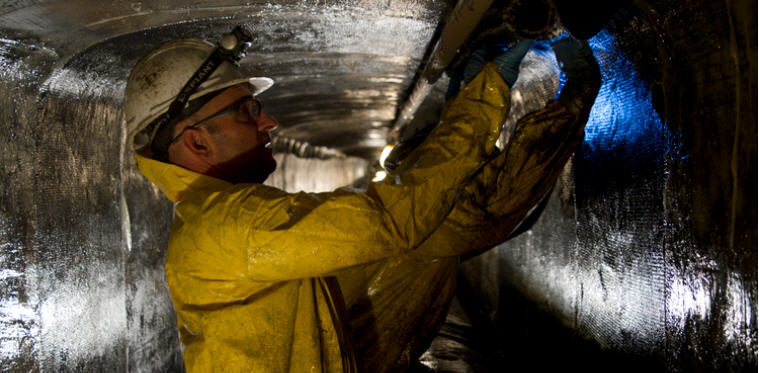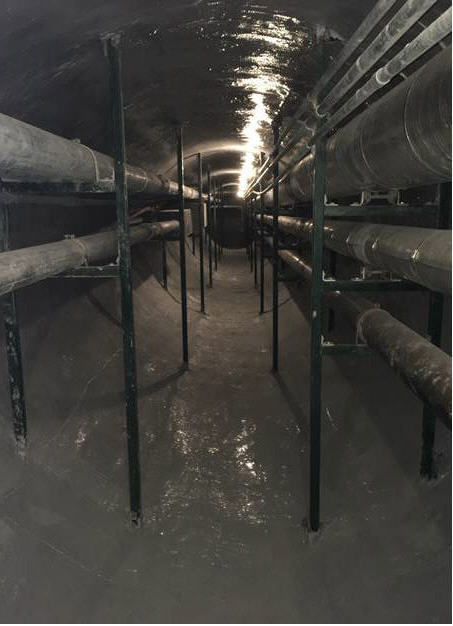New wet-layup tunnel repair method proves faster, less expensive and far less disruptive of academic activities than conventional repair methods
 Workers apply carbon fiber mats soaked in epoxy resin to stabilize the tunnels that crisscross under the University of Arizona campus.
Workers apply carbon fiber mats soaked in epoxy resin to stabilize the tunnels that crisscross under the University of Arizona campus.
TUSCON, ARIZ., January 21 - Repairs made by strengthening existing structures with innovative fiberglass-reinforced polymer (FRP) materials have recently been made with great success on college campuses.
Mo Ehsani, professor emeritus in the University of Arizona's College of Engineering, pioneered the concept of repairing and strengthening existing infrastructure with FRP to resist earthquakes and blasts with fiber-reinforced polymer in the late 1980s. Now his company, QuakeWrap, a member of the International District Energy Association (IDEA), is using carbon and fiberglass reinforced epoxy composites to repair underground tunnels, piping and building structures quickly and quietly, compared with conventional methods that require long downtimes and the use of heavy equipment.
The University of Texas at Austin, also an IDEA member, contacted QuakeWrap in 2016 to do an inspection and potential repair of a large cooling water pipe, steam tunnels, and support columns at District Cooling stations as well as to make tunnel repairs. The university gave highest priority and the go-ahead to repair wall supports at Cooling Station 3 (CS3). Repairs were completed in 2018. Other issues, including repairing a section of the university’s tunnel system that suffered rebar corrosion and concrete spalling due to large amounts of water infiltration, are on hold for future budgets.
CS3 cooling tower screenwall support beams were plagued with excessive corrosion and concrete spalling, with failure imminent. Complicating matters, CS3 has very limited accessibility. Instead of time-consuming replacement of the beams, QuakeWrap subsidiary FRP Construction wrapped the beams with a wet epoxy-saturated fiberglass substrate, filled the annulus space with grout and coated the fiberglass with an additional layer of epoxy.
The process restored the original strength of the beams and took only a few days, compared with weeks and much higher cost that would have been required by replacement. Equally important, the FRP process allowed the cooling station to continue to operate for most of the repair period.
Said Ryan Thompson, Maintenance Manager at UT Austin, “QuakeWrap FRP is for anybody who has aging infrastructure. For us it was the cooling tower screenwall structure, which was badly damaged and leaning. QuakeWrap had structural engineers come in and do an assessment. Their subsidiary FRP Construction came in and did a great job. They epoxied the spalling areas, wrapped it, and after setting took test coupons to be sure outer layers adhered and were hardened.
Not only did they solve a safety issue, but they finished the job early with a wet lay epoxy fiberglass wrap specialty product.”
“We are now looking at them for remediation for a building façade that needs repair,” said Thompson. “It would also be good for cooling tower internals. We appreciate the end product—makes me feel better to know it was done. It was a good experience. We’d use them again.”
At another IDEA member campus, the University of Arizona (UA) in Tucson, some of the utility tunnels that crisscross beneath the campus are 80 years old. Two types of tunnel failure were both solved with FRP repairs. The wet-layup FRP repair method came about through a collaboration involving UA Planning, Design and Construction, UA Facilities Management and Ehsani's company, QuakeWrap.
In older tunnels made of concrete, water seeping into the ground penetrated cracks in the concrete tunnel ceilings. The deterioration accelerated as the water reached the steel rebar, which rusted and expanded, widening the cracks in the concrete. In another area of campus, a 10 year-old tunnel built with a 6-foot-diameter steel pipe suffered serious corrosion due to water infiltration, opening a large gap in the top of the pipe.
In both cases, repairs were effected using wet-layup carbon fiber-reinforced polymer (CFRP) composite materials.
After cleaning loose materials from the tunnel surfaces, workers applied the CFRP sheets saturated with epoxy to the tunnel ceiling and walls. The CFRP sheets cured over the course of about a day and resulted in a rigid lining that is three to four times stronger than steel, said Ehsani, who served as a faculty member in the UA Department of Civil Engineering and Engineering Mechanics from1982 until 2010.
"The epoxy serves two functions: It distributes the load among the individual carbon fibers, which are microscopically thin, so they all participate in distributing the load. It also protects them against abrasion," he said. "Even though these mats are applied like a fabric, they provide the equivalent of 1-inch steel bars placed a foot apart inside the tunnel."
 After: Inside repaired utility tunnel under the University of Arizona campus.
After: Inside repaired utility tunnel under the University of Arizona campus.
QuakeWrap Inc.
6840 S. Tucson Blvd.
Tucson, AZ 85756 U.S.A
Phone: (520) 791-7000
Fax: (50) 791-0600
Toll Free: (866) QuakeWrap [782-5397]
www.QuakeWrap.com
#News#MemberNews#QuakeWrapInc#UniversityofArizona#UniversityofTexasAustin#Pipes#Infrastructure#UnitedStates